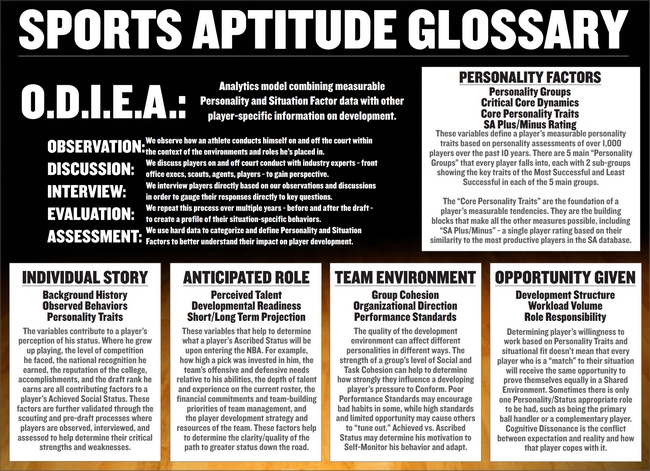More From Sports Aptitude
-NBA Market Watch: Will Barton
-Opportunity Knocks: What's Trending in Development
-Opportunity Knocks: Fitting In vs Fitting Out
-Opportunity Knocks: The Pluses and Minuses of Success
-The DeAndre Jordan Rules
-DeMarre Carroll's Long and Winding Road to Stardom
-The Unbearable Lightness of Patrick Beverley
-Everybody Loves Draymond Green
-Jimmy Butler's Rise to Stardom
-How Situation Impacts Success, Part Two
-How Situation Impacts Success, Part One
-The Thin Line Between Busts and Steals
Not everyone is blessed with such game-changing talent, however. If mindset alone determined success, there'd be more confusion between the Black and White Mambas. Having the right ingredients for a winner's mentality only works if you know the Situation Factors necessary to get cooking.
What if the Mavericks pulled the plug on Steve Nash after one season because he was a defensive liability who couldn't create his own shot well enough to be a starting point guard? How many players get a second lease on life as a starter after shooting 36% from two-point range with a net rating of negative 9.6?
The next Mark Price could have easily become the first Jimmer Fredette if Dallas had used the wrong recipe for Nash.
Optimum effectiveness so often relies on simple math: Personality x Situation = Success
The equation is simple enough. The devil is in the details, as they say. A person has an estimated 60,000 thoughts each day. The nature of these thoughts is influenced by the situation that person is in. A person's personality traits are the tendencies those thoughts are filtered through.
Finding success is about understanding how the demands of a situation mesh with the personality of the individual, and how that combination will translate those 60,000 thoughts into action.
SAPM BY CATEGORY
Breaking down players into general categories is the first place to start. Grouping players by their commonly shared traits helps to identify behavioral patterns shared by multiple individuals. Observing multiple individuals helps to avoid making as many mistakes when evaluating the cause of those actions, in terms of analyzing cause and effect between personality and situation.
Every SAPM category has its share of successes and struggles. However, SAPM uses shared personality traits to categorize players based on the quantity of players earning the most minutes and producing the most in the minutes they earn. Simply put, the higher the SAPM category rank, the greater the volume of NBA players earning opportunity and producing.
Looking at developmental trends over eight years of college and professional careers has helped to identify some situation-specific performance indicators that are unique to each of the 5 SAPM Species of player. These indicators help to tell the story of what is influencing player development and significantly impacting the frequency of success for each of the 5 SAPM groups.
A bit more depth on Personality and Situation can be found using the links and in the Glossary of Terms listed below.
TOP SAPM = Largest Quantity of High-Minute/High-Production Players
Personality: The Star players within this group highly value the opinions of others, have excellent self-discipline, tend to be more trusting, and constantly self-review their own decision-making relative to their individual standards and those set by their team.
Situation: This group is by far the easiest to project success from college to the pros, having the highest overall Risk/Reward rating in SA's Adaptability/Productivity/Growth Rate Situational Development model (see table of contents below). Simply put, these players tend to live up to expectations in college and exceed them as professionals. They are almost always ready to capitalize on the opportunities given to them, but may not force the issue when necessary to create a greater opportunity for themselves.
Success: Draymond Green is the quintessential TOP SAPM success story in many ways. His constant improvement over four seasons in college is typical of this group (second in IMPROVEMENT). His team was also successful with him playing a pivotal role, another trait common to collegiate TOP SAPM players (first in IMPACT).
Despite this success, Green went in the second round of the draft, just like every NBA TOP SAPM player before him who was not a Top-50 ranked high school recruit. His winning personality quickly earned him a steady role on a fast-improving team (first in SURVIVAL). But it wasn't until the injury bug struck that he was given the green light to expand his game (fifth in VOLUME).
HIGH-MID SAPM = 2nd Largest Quantity of High-Minute/High-Production Players
Personality: These players are also relationship-based decision-makers, like the group above, but with some significant differences. The stars of this group tend to be much more independent-minded, impulsive, and change-seeking than their more ridged TOP SAPM counterparts. They're often unrestrained when it comes to defending their viewpoints and tend to have a very carefree mentality, which can be confused for a lack of self-awareness at times.
Situation: This group enjoys the most significant change in terms of their Risk/Reward projection from college to the pros. After the one and done crop of the highest rated high school players, the rest of this group tends to be significantly undervalued in terms of draft stock. This could be due to their generally inconsistent play on the collegiate level, coupled with the perception that they lack the overachievers mentality. Whatever the case may be, these players have a strong desire to prove themselves and benefit greatly from being around strong role models they respect. As such, the four year NBA return on investment is the second highest among the five SAPM groups.
Success: Karl-Anthony Towns fits the mold of the HIGH-MID player. A top-50 high school recruit on an elite college program, Towns was still somewhat under the radar as a prospect. Towns ranked a mere seventh on Kentucky in minutes, despite being the most productive per-minute player on his team by a significant margin. Somehow HIGH-MID's historically tend to run into an invisible wall that prevents them from frequently earning a larger role, despite maxing out their performance with what they're given.
HIGH-MID's seem to exist in a situational caste system where their High School and NBA Draft rankings dictate the type of role opportunity they receive at the NCAA (fifth in STATUS) and NBA (fourth in STATUS) levels. Towns was fortunate to be born into the highest caste, who happen to be the top NBA performers as well. This is actually true for all HIGH-MID players (first in STATS), which makes their inability to move up the food chain perplexing.
MID SAPM = Middle Quantity of High-Minute/High-Production Players
Personality: This group may be the most situation-dependent when it comes to success. Their core traits are a mix of independence and accountability that makes the circumstances around them critical for how they develop. They are persistent and tend to be driven by a strong desire to prove themselves. The stars of this group worry less about gaining control and influence over others and more about earning respect through their accomplishments.
Situation: These players often kill it at the college level (second in PRODUCTIVITY). However, the high ranking high school studs have the lowest percentage of players taken in the first round as freshmen and sophomores. It's actually the less heralded recruits that realize the most collegiate success (first in EXCEED). In terms of NBA success, this is clearly the group that benefits from the mantra stay in school as they have the lowest SURVIVAL rate at both levels. Those that enter the league ready to contribute from day one quickly move up the ranks (first in STATUS).
Success: Steph Curry is the poster-child for MID SAPM success stories, having played four years in college and coming into the league with a skillset that was ready to wear. Being acutely aware of the expectations, but not being compelled by a need for approval is a signature trait of the best MID's - confident, competitive, non-controlling; with a stick-to-it persistence.
Curry's situation was just right among this Goldilocks group. The perfect blend of a player who has some NBA ready skills coming into the league, earns a foothold in the rotation, but is challenged by quality of the team environment to adapt to keep up. If the environment is too cold the good MID players become stats-padders on bad teams. Too hot and there is not enough early opportunity to mold that willfulness through trial and error on a veteran, winning team.
LOW-MID SAPM = 2nd Lowest Quantity of High-Minute/High-Production Players
Personality: Players in this group tend to be governed more by their emotions than any other group. They are often high strung and more reactive to the emotional tenor of their team environment. They are more trusting and sensitive to threats than other players as well. These traits indicate an acute sensitivity to what's going on around them, their performance being a reflection of their surroundings.
Situation: LOW-MID's are often highly successful in college (first in IMPROVE and STATUS, second in EXCEED) despite low ratings in minutes, usage, and production relative to the other groups (fifth in VOLUME). They also tend to get drafted high, with non-RSCI Top 50 players having the highest percentage of first round picks overall. Perhaps their streakiness as players is outweighed by their sense of the moment and ability to be at their best in big situations. On the NBA level, they continue to trend upward (first in VOLUME, second in IMPROVE and EXCEED) but are highly impacted by the quality of their NBA team environment (fourth in Engage).
Success: Klay Thompson's presence as the third Warrior example says as much about him as it does about the trio itself. Team cohesion is a critical component to LOW-MID success. Though Thompson is a little less volatile than the average HIGH-MID; he has the threat-sensitive, analytical, and quick to seek change traits that can distract/dissuade LOW-MID's when things don't feel right.
But Thompson had the duel benefit of finding early opportunity on a team that was just coming together. He only had to endure one losing season before Curry was fully affirmed in his role as the point guard, leaving Thompson the keys to the other backcourt position on the table. With task cohesion beginning to take hold, it was only a matter of time before the irresistible force that is Draymond Green synergized the social cohesiveness of the group as well clarity, comradery, winning LOW-MID staples.
BOT SAPM = Lowest Quantity of High-Minute/High-Production Players
Personality: Bottom (BOT) SAPM players are defined by their introverted tendencies. They tend to be more observant than interactive, often with strong personal habits and rituals that can be difficult to change. The stars among this group tend to be fairly single-minded basketball junkies who live in the gym and have had the luxury of playing roles that have only required gradual change over time.
Situation: It's not hard to look at the situational data and hypothesize that the least successful players in this group may not really be passionate about basketball. This group of players has the highest amount of underachievers when it comes to high school to college (fifth in EXCEED, ENGAGE, and STATS) and college to pro performance (fifth in GROWTH RATE, fourth in PRODUCTIVITY) among first round picks.
Success: Kawhi Leonard is a perfect example of a BOT SAPM success story and a testament to the critical and substantial differences between the have's and have not's of this group. Leonard is introspective to the extreme stoic and unemotional on the court with a constant awareness of what's going on around him. By all accounts he may be the least attention seeking star in the history of basketball, which is saying something considering he plays with Tim Duncan.
The lack of a demonstrative personality coupled with a suspect jumper likely did him no favors when it came to selling himself as a player before his success. For many people visible, emotional passion directly translated to interest and dedication; a lack of it can cause question and concern. But Kawhi has it where it counts for BOT's Dominance and Mental Toughness. These two traits are a staggering 27% higher in Star BOT's vs. their pay check pushing counterparts. In these two categories, Leonard is a super-human 38% above the norm.
TABLE OF CONTENTS


























Comments